Can an €80m art center energize the Spanish seaport city of Santander?
Pritzker-winning Italian starchitect Renzo Piano completes five-year project to build Botín Center
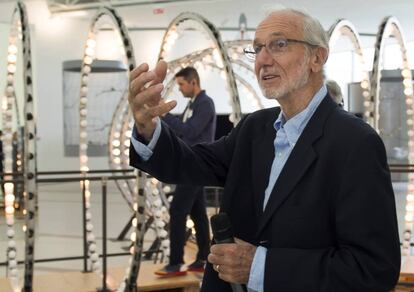

When Renzo Piano landed in Santander on Wednesday of last week, he began to worry. It was sunny. Fortunately, on the following day the Italian architect was able to enjoy the northern Spanish city’s typically overcast weather, where it always looks like it’s about to rain.
“Ah, yes, this is Santander,” he said, looking out the window of his room. Piano, 79, needed that grayish-greenish light that produces the inspirational mood behind his recently completed project in the city, the Botín Center.
The Pritzker-winning creator of landmark art buildings such as the Pompidou Center in Paris and the Whitney Museum of Modern Art in New York showed this new space to the media a day before its official inauguration by the king and queen of Spain.
Some in the city opposed a building that blocks the open views of the mountains from the bay area
The Botín Center, named after the founding family behind the powerful Santander banking group, has been five years in the making.
Meant as a new social space for art and creation, the project comes at a cost of €80 million and counting – the final total is still being added up – and was funded entirely by the Botín Foundation.
In 2012, Piano was asked by the Santander Bank chairman at the time, Emilio Botín, to design a building that would house the Botín Center. The banker was in a hurry and wanted the project delivered by 2015 or around that time.
“But a project like this takes time,” says the Italian architect, happy to see his first Spanish project finally completed, but saddened by the fact that his employer, who died of a heart attack in September 2014, was not there at the inauguration.
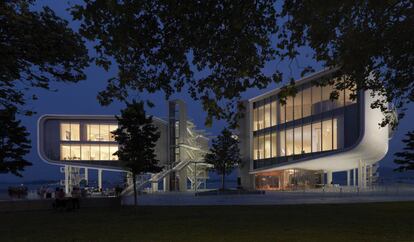
The current chairman of the Botín Foundation, his son Javier Botín, on Wednesday thanked everyone involved in the project.
“My father made it clear that there are three criteria that we have to respect: our project has to be social through creativity and art. It also strives to have a global impact, yet must encourage local action. Santander and [the region of] Cantabria should be the stars of the change that this center means for the whole of Spain.”
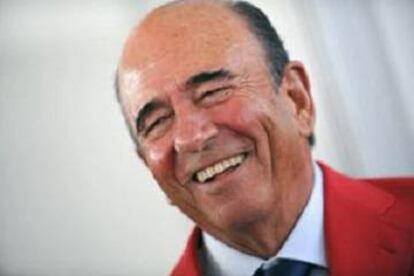
Fátima Sánchez, the executive director of the Botín Center, said that one of the goals is to “improve, articulate and energize” the cultural scene along the Cantabrian coast. Other port cities in northern Spain have already undergone their own transformation through major cultural projects, with the most famous example being Bilbao and the Guggenheim Museum.
Spanish partner
Renzo Piano partnered with the Spanish studio Luis Vidal, and together they planned a building on the city’s waterfront that “had to fly.” It also had to be discreet and blend in with a landscape that breaks the barrier between the Pereda Gardens and the bay, with the ever-changing water conditions and light as a connecting element.
Its creators were not seeking to build an iconic building, but they did want something that would make local residents proud. “It would be too arrogant to aspire to that, although, as a public space, it must have its dignity,” said Piano during the tour.
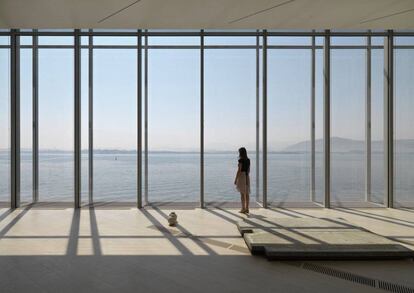
The building also had to break another barrier: the one separating the city center from the suburbs that extend towards the docks in the fishing district and in the new port area.
“It’s very hard to change port cities; they are like industrial cities. They require the time, pace and patience of an elephant,” said Piano. “But in the end, it happens. And we hope that this will be the case here as well.”
“This city has a metaphysical relationship with its atmosphere,” he added. “It has changing weather, it blends seamlessly with the rain, it coexists with the sea. I understand this well, because saltpeter is also my element: I am from Genoa.”
The project has not been without its controversial moments. First, there was the matter of location. Some people in the city opposed the idea of a building that would block the open views of the mountains from the bay area.
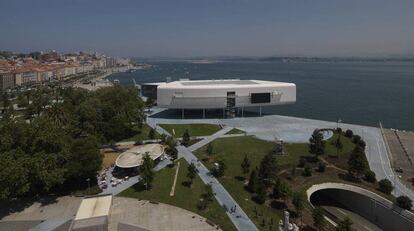
There was also some bad blood between the construction companies OHL and ASCAN. And then there was the budget, which kept ballooning even before the project was completely locked in, according to sources at the companies in charge of construction. These cost overruns triggered a renegotiation of the terms and a halt to all construction work for several months in 2016.
Piano and Vidal listened to the city’s proposals and even embraced a certain amount of criticism: “You need to tiptoe into places that you don’t know. We need to adopt the humble attitude of learning to listen,” says Piano. “Even though the project is essentially the same one it was at the beginning, we saw that in some aspects, some of the criticism was right, and we incorporated changes.”
The architect admitted that he felt a little nervous about the public’s reaction to the new center. “Until Friday, this will be ours, but after that, with a certain sadness, we will have to say farewell and hand it over to the people who will truly enjoy it.”
For starters: Goya and Carsten Höller
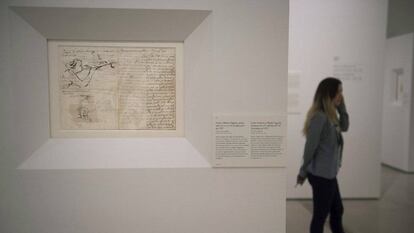
An exhibition of Goya drawings and another featuring the work of Belgian artist Carsten Höller are inaugurating the ample space at the brand new Botín Center in Santander. The Goya show, which is on until late September, was made possible thanks to the Prado Museum in Madrid. Besides the artwork, the center also features a restaurant named El Muelle, run by Jesús Sánchez – considered the king of regional cuisine and holder of two Michelin stars for his eatery El Cenador de Amós.
English version by Susana Urra.
Tu suscripción se está usando en otro dispositivo
¿Quieres añadir otro usuario a tu suscripción?
Si continúas leyendo en este dispositivo, no se podrá leer en el otro.
FlechaTu suscripción se está usando en otro dispositivo y solo puedes acceder a EL PAÍS desde un dispositivo a la vez.
Si quieres compartir tu cuenta, cambia tu suscripción a la modalidad Premium, así podrás añadir otro usuario. Cada uno accederá con su propia cuenta de email, lo que os permitirá personalizar vuestra experiencia en EL PAÍS.
¿Tienes una suscripción de empresa? Accede aquí para contratar más cuentas.
En el caso de no saber quién está usando tu cuenta, te recomendamos cambiar tu contraseña aquí.
Si decides continuar compartiendo tu cuenta, este mensaje se mostrará en tu dispositivo y en el de la otra persona que está usando tu cuenta de forma indefinida, afectando a tu experiencia de lectura. Puedes consultar aquí los términos y condiciones de la suscripción digital.
More information
Archived In
Últimas noticias
Maduro pleads not guilty before the federal court in New York: ‘I am still the president of Venezuela’
A new test can detect Alzheimer’s from a finger prick
UN team enters Sudanese city of El Fasher after paramilitary massacre: ‘It’s like a ghost town’
A recipe for resistance: Indigenous peoples politicize their struggles from the kitchen
Most viewed
- Gilles Lipovetsky: ‘If you want to live better and fall in love, take Prozac, don’t look to philosophy’
- Alain Aspect, Nobel laureate in physics: ‘Einstein was so smart that he would have had to recognize quantum entanglement’
- Alvin Hellerstein, a 92-year-old judge appointed by Bill Clinton, to preside over Maduro’s trial in New York
- Maduro’s downfall puts China’s relationship with Venezuela to the test
- Why oil has been at the center of Venezuela-US conflicts for decades









































